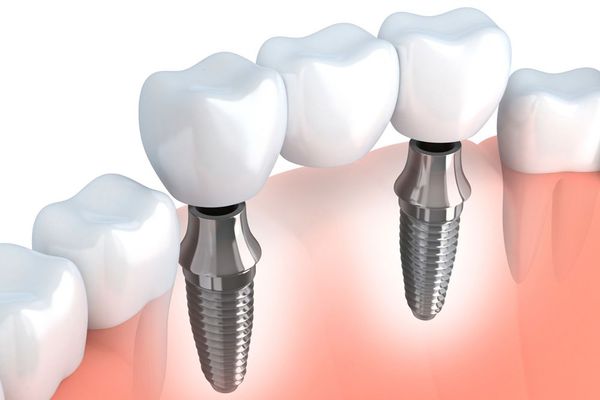Implant-Supported Bridges: Lifelong Restorations for a Fuller and Stronger Smile
Implant-supported bridges are a secure, durable, natural-looking replacement for two or more missing teeth in a row. Dr. Art Carpenter continually pursues ongoing education to provide our Kenilworth, IL, patients with the long-lasting benefits dental implants offer. Dental implants have become the gold standard in tooth replacement, and Dr. Carpenter’s advanced training ensures the greatest precision and accuracy in their placement and restoration.

Bridges supported by dental implants provide long-term support for your smile.
Implant-Supported and Traditional Bridges
Both implant-supported bridges and traditional bridges consist of multiple crowns fused together. However, a traditional bridge will attach to your natural, healthy teeth that sit on either side of the gap in your smile. With traditional restorative treatment, patients who were missing a single tooth would require a bridge that sacrificed two healthy teeth for support. Now, dental implants allow patients to replace a single tooth with only one implant post and a customized crown. For patients missing more teeth, an implant-supported bridge will typically rely on two state-of-the-art implant posts for stability. As a result, your healthy teeth will require no alteration, helping them to remain strong and whole long into the future.
Additionally, dental implants provide bone stimulation, which prevents jaw deterioration. Bone loss is a natural consequence of tooth loss. Traditional bridges replace only the missing portions of the tooth above the gum line—not the roots—so bone deterioration continues. An implant-supported bridge replaces the full structure of a tooth, halting bone loss and improving dental function.
Candidates for Implant-Supported Bridges
Patients missing two or more teeth in a row are generally good candidates for an implant-supported dental bridge. To qualify for treatment, you must have adequate bone tissue to support dental implants. If bone loss has already taken place, you may require a bone graft to improve jawbone density or a sinus lift to increase your eligibility for treatment.
In addition to good jawbone health, you must also have healthy teeth and gums, free from disease and decay. While implant posts can last a lifetime, that is only possible with proper care. You should also be a non-smoker, as smoking can cause implant failure. Lastly, it is important to commit to diligent at-home care and regular dental cleanings and exams with our doctors.
Dr. Carpenter can help you plan a customized treatment to achieve your oral health goals and improve your quality of life.
Treatment Process
Dr. Carpenter will first meet with you to discuss your unique case. Together you can determine the number of implants you will need and design your surgery for precise treatment. The number of implants placed will depend on the number of missing teeth, but most patients need at least two posts. You will then undergo a minor procedure to receive your implant. Once the posts are in place and you begin healing, osseointegration can occur. This process can take between three and six months, during which the implants will permanently fuse with your jawbone.
When the osseointegration phase is complete, Dr. Carpenter can attach abutments or connector pieces to the implants. After a brief two-week recovery, our team can take impressions and fabricate your custom restoration from lifelike materials. When the bridge is ready, Dr. Carpenter will affix it to the implants, giving you a full and aesthetic smile.
Achieve a Healthy, Strong Smile
If you want a fuller smile with restorations that can last a lifetime, contact our office online or call (847) 251-5004 to learn more about our implant-supported restorations. Dr. Carpenter can help you plan a customized treatment to achieve your oral health goals and improve your quality of life.






